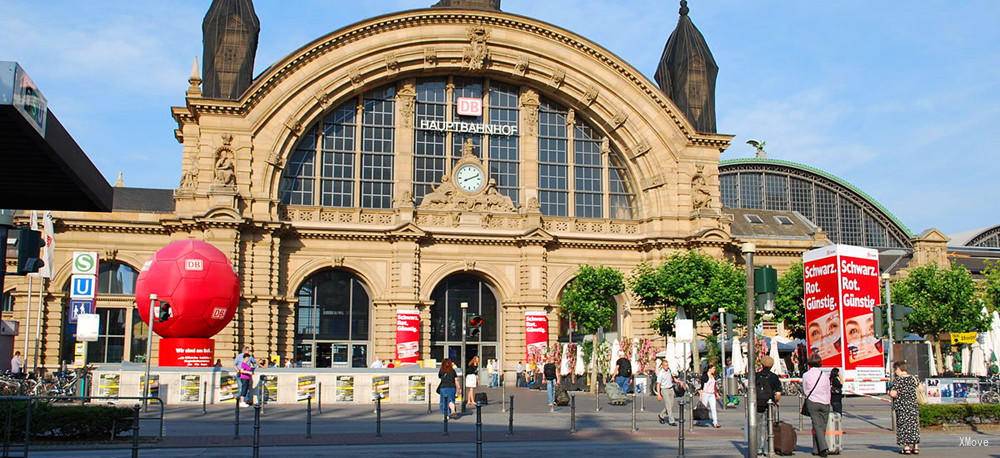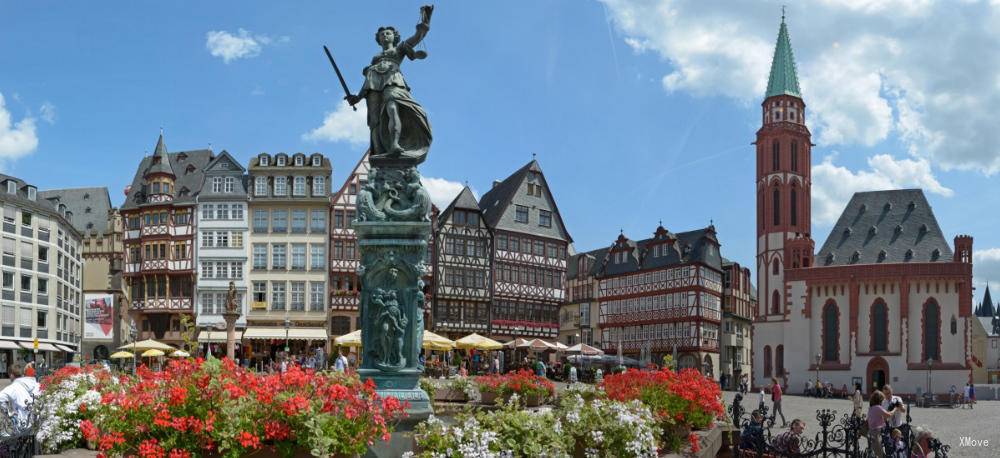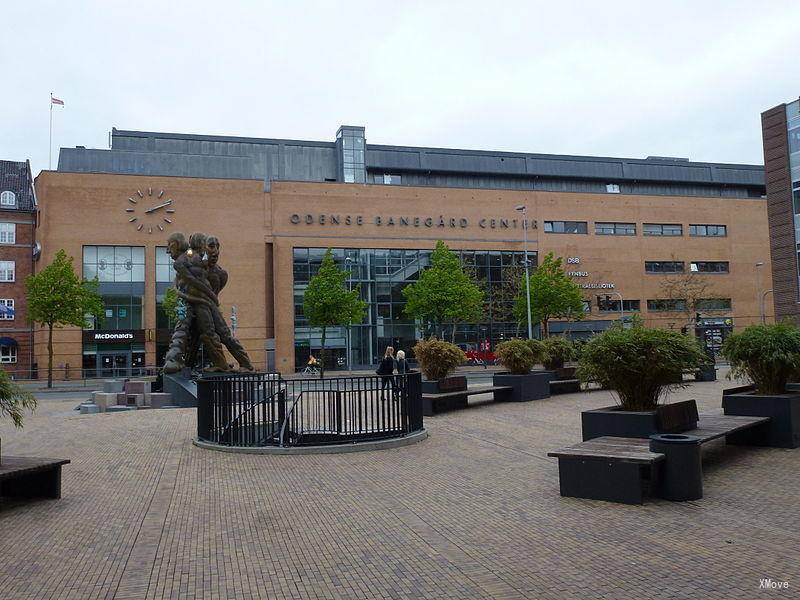Frankfurt Central to Odense St: Trains, Buses, Fares, Today's Connections, Routes, Duration, Types of Trains, Station Guides, Tips, Journey
Germany Train Tickets
Scan QR code, download App to see Frankfurt Central's more live update, station guide, plan and photos



Train schedule Frankfurt Central(Frankfurt(Main)Hbf) to Odense St
Popular train routes departing from Frankfurt Central(Frankfurt(Main)Hbf)
* Metz Ville
* Berlin
* Koeln Messe Deutz Gl 11 12(Köln Messe/Deutz Gl.11 12)
* Warszawa Central Station(Warszawa Centralna)
* Bonn Central Station (B1)(Bonn Hbf (Tief))
* Wertheim
* Wolfsburg Central(Wolfsburg Hbf)
Popular train routes arriving in Frankfurt Central(Frankfurt(Main)Hbf)
* シュトゥットガルト中央駅(Stuttgart Hbf)
* インターラーケン西駅(Interlaken West)
* ミュルーズ(Mulhouse Ville)
* ベルリン(Berlin)
* バンベルク(Bamberg)
* ハーゲン駅(Hagen Hbf)
* ハンブルク中央駅(Hamburg Hbf)
Popular train routes departing from Odense St
* Hamburg Central(Hamburg Hbf)
* Rostock Central(Rostock Hbf)
* Augsburg Central(Augsburg Hbf)
* Bern Hbf
* Heidelberg Central(Heidelberg Hbf)
* Berlin Central Station(Berlin Hbf)
* Goettingen(Göttingen)
Popular train routes arriving in Odense St
* கோபன்ஹேகன்(København)
* Jessen(Elster)
* கோபன்ஹவன் எச்(Köbenhavn H)
* ட்ரையர் எச்.பி.எஃப்(Trier Hbf)
* வார்சா(Warszawa)
* பாஸல் எஸ்.பி.பி.(Basel Sbb)
* டார்ட்மண்ட் மத்திய நிலையம்(Dortmund Hbf)

Frankfurt Central
The Frankfurt Hauptbahnhof is the busiest railway station in Frankfurt, Germany. The name "Main" comes from the city's full name, Frankfurt am Main. Due to its location in central Germany and as a hub for long-haul and short-distance travel, Deutsche Bahn is known as the most important station in Germany.
For long-distance traffic, the station benefits from a location in the heart of Europe; 13 of the 24 German High Speed Rail (ICE) lines stop at the site and 2 of the 3 ICE Sprinter lines. In terms of regional transportation, Frankfurt Hbf is the main hub of the RMV network, providing connections to nearby destinations, including Koblenz, Fulda, Würzburg, Mannheim, Heidelberg, and fifteen regional lines at the station. . The station is also a subway interchange station.
Frankfurt Central - Station Guide | Departures and Arrivals | Popular Routes
Frankfurt
City Overview
There are two cities in Germany called Frankfurt, one for Frankfurt am Main and the other for Frankfurt (Oder). The former will be your destination for this trip, while the latter is a city on the German-Polish border.
Frankfurt am Main, Germany's fifth largest city, located in the central and western part of Germany, Hessen, on the right bank of the Main River, close to the intersection of the Main River and the Rhine, with Wiesbaden, Dam Stadt is adjacent to Mainz. Since 794 AD, it has gradually developed into a diversified city. She has a strong cultural heritage and is the hometown of the famous German poet Goethe. It was the election and crowning of the German Emperor from the 14th to the 18th century. She is one of the global financial centers, the European Central Bank, the third largest stock exchange in Europe, and the German Central The bank is home to more than 400 international banks. After the reconstruction of World War II, she became a modern metropolis, famous for its numerous Skylines, known as “Manhattan on the Rhine”; Two major airports, the busiest meeting place in Europe.
Must visit attractions
- ##### Frankfurt Roman Forum Frankfurter Römer
The Roman Forum is the town hall square in Frankfurt since the Middle Ages, the heart of Frankfurt's Old Town. It is located in the north of the Meiyin River Bridge, on the west side of the City Hall, on the southwest side of the Wertheim House, a beautiful residence in the late Renaissance style (1600), and on the south side is the 13th century St. Nicholas. The church is built with red sandstone. The east side is a wooden rib wall house built in the 15th to 18th centuries. On the north side is a stone house (1464) built in the style of an Italian palace. In the center of the square stands the Fountain of Justice (Gerechtigkeitsbrunnen), which was built in 1543. 200 meters to the east is the birthplace of Frankfurt, the birthplace of the city. In 1944, the square was violently attacked by the British Air Force, almost completely destroyed and rebuilt after the war.
Address: Roemerberg 27, 60311 Frankfurt, Hesse, Germany (view map) * ##### Messe Frankfurt Messe Frankfurt
The Frankfurt Messe Exhibition Centre consists of ten halls with a total area of 400,000 square meters, of which the exhibition area is 263,000 square meters, making it the third largest exhibition hall in Germany. More than 50 exhibitions are held here every year, including book fairs, auto shows, and spring and autumn consumer products exhibitions, which are the largest of its kind in the world. Important exhibitions include the Consumer Goods Fair, the International Automobile and Parts Fair and the Frankfurt Book Fair.
Transportation: Take the 16 or 19 tram; take the 3/4/5 city railway from the central station to the Messe Frankfurt station.
Gourmet & Accommodation & Shopping
- ##### Gourmet
Frankfurt is the first stop for most visitors to Europe and the most cosmopolitan city in Germany. Although Germany is not famous for its food, it will never be ill-treated by the stomach of the foodies. Speaking of the cuisine of Frankfurt, I believe that the first reaction of many people is the Frankfurt sausage. In fact, in addition to sausages and pigs, the local specialties include schnitzel, apple wine (Apfelwein), green sauce and cheese (Handkäse mit Musik). Don't be misled by the name "Music with cheese", think it is a cheese that will play music. In fact, the music here refers to the seasonings of cheese mixed with onions, vinegar and other ingredients. It is said that this wonderful mixture will produce some kind of gas after the lower belly, so that your body begins to sing.
- ##### Accommodation
Frankfurt is the European financial centre, and the European Central Bank and the German Central Bank are both located on the Main River. Frankfurt has a classically converted hotel with a rich life and rich cultural heritage. The train station and the city centre are popular places for travellers, and there is also a modern and luxurious hotel that reflects the vitality of the hotel.
- ##### Shopping
When coming to Germany, German electronics, household items, cosmeceuticals, perfumes, ice wine, chocolates, etc. are all good shopping options. The shopping districts of Frankfurt are relatively concentrated, with major commercial streets and large shopping malls in the city centre! In the discount season, the major brands of the major brands are quite strong, especially the German brand. In addition to commercial streets, shopping centers, there are outlet shopping villages near Frankfurt.
Urban traffic
The status of Frankfurt buses in urban public transport operations is not important. The main public transport is done by rail transit. There are some bus lines in the north of the city.
The Frankfurt tram is Frankfurt's first rail system and an important part of the Frankfurt public transport system. Frankfurt is the total length of the tram track 63.55 km.
Frankfurt Light Rail S-Bahn Frankfurt has 9 light rail lines that can be used to travel to other nearby cities such as Wiesbaden, Mainz and Darmstadt. The inbound port has a clear yellow-green “S” sign and sometimes shares an entrance with the subway. When buying a light rail ticket, you need to pay attention to the difference between the 50th and 5090 districts, the first-class train and the second-class train. If you buy the wrong or sit wrong, you will be fined. The light rail lines are much more complicated than the subway, and they need to be more careful when looking at the traffic map, but they all pass through the train stations (Hauptbahnhof), Hauptwache and Konstablerwache. S-Bahn's operating hours are generally from 4:00 to 1:00 am the next day, but the interval between each shuttle is longer than the U-Bahn. It is necessary to pay attention to the fact that when the vehicle is getting on and off, the button on the door needs to be pressed, and the door will open.
Frankfurt Underground U-Bahn Frankfurt has eight metro lines, all running in downtown Frankfurt. The direct distance from each station is not very far, and the subway entrance has a clear blue “U” mark, which is easy to find. The information screen on the subway station will display 4 upcoming trains, the arriving terminal and the main station passing by. There will be a clear road map when entering the subway station. Please read it carefully and avoid the wrong direction. U-Bahn's operating hours are generally from 4:00 until 1:30 am the next day. The specific operation time of each line is subject to the information in the subway station.
Frankfurt bicycle There are plenty of bicycle trails in Frankfurt for tourists to go cycling between April and December. The more convenient car rental company for tourists is Deutsche Bahn. Look for the red and white logo with the DB letter on the roadside, especially on the street corner. Those are the main pick-ups and return points. With a mobile phone and a credit card, you can rent a car 24 hours a day, 7 days a week.
Frankfurt taxi It is not difficult to take a taxi in Frankfurt. Taxi parking spots can be found everywhere (eg Römer / Braubachstrasse, Kaiserstrasse, Schweizer Platz, Bockenheimer Warte). In the evening, it is best to find a slightly better driver. Get off the bus and remember to have a small ticket with the driver, in case you need it. Taxi in Germany is less likely to have a detour. The driver's car has navigation. If you are going to a place that is not particularly easy to find, you can tell them the house number or zip code. The average price of a taxi is 2.5 Euros, and then 1.65 Euros a kilometer. Most drivers now accept credit cards. In the main sightseeing area of the city center, visitors who do not want to walk can choose to take the “human rent”, which can pull 1-2 people each time.
Frankfurt - Guide, Attractions, Tours, Sightseeings | Train from/to Frankfurt | Popular RoutesOdense (, also US: , Danish: [ˈoðˀn̩sə] ) is the third-largest city in Denmark. It has a population of 178,210 as of January 2016, and is the main city of the island of Funen. By road, Odense is located 45 kilometres (28 mi) north of Svendborg, 144 kilometres (89 mi) to the south of Aarhus and 167 kilometres (104 mi) to the southwest of Copenhagen. The city is the seat of Odense Municipality and was the seat of Odense County until 1970, and Funen County from 1970 until 1 January 2007, when Funen County became part of the Region of Southern Denmark. Odense has close associations with Hans Christian Andersen who is remembered above all for his fairy tales. He was born in the city in 1805 and spent his childhood years there. There has been human settlement in the Odense area for over 4,000 years, although the name was not mentioned in writing until 988, and by 1070, it had already grown into a thriving city. Canute IV of Denmark, generally considered to be the last Viking king, was murdered by unruly peasants in Odense's St Alban's Priory on 10 July 1086. Although the city was burned in 1249 following a royal rivalry, it quickly recovered and flourished as a centre of commerce in the Middle Ages. After a period of decline, large-scale plans for development were made during the 18th century, which led to the rebuilding of Odense Palace and the building of a canal to the Port of Odense, facilitating trade. In 1865, one of the largest railway terminals in Denmark was built, further increasing the population and commerce, and by 1900, Odense had reached a population of 35,000. Odense's Odinstårnet was one of the tallest towers in Europe when built in 1935 but was destroyed by the Nazis during World War II. The University of Southern Denmark was established in 1966. In the present day, Odense remains the commercial hub of Funen, and has a notable shopping district with a diversity of stores. Several major industries are located in the city including the Albani Brewery and GASA, Denmark's major dealer in vegetables, fruits and flowers. The city is home to Odense Palace, erected by King Frederik IV who died there in 1730, the Odense Theatre, the Odense Symphony Orchestra, and the Hans Christian Andersen Museum, situated in the house that was the birthplace of Hans Christian Andersen. In sports, Odense has a number of football clubs including OB, BM, B1909, and B1913, the Odense Bulldogs professional ice hockey team, and the city also hosts the H.C. Andersen Marathon. Odense is served by Hans Christian Andersen Airport and Odense station, which lies on the line between Copenhagen and the Jutland peninsula.
Odense - Guide, Attractions, Tours, Sightseeings | Train from/to Odense | Popular Routes
Germany Train Tickets
Scan QR code, download App to see Frankfurt Central's more live update, station guide, plan and photos



Hot Journeys
* Swiss Alps Jungfrau Aletsch -> Lauterbrunnen
* Frankfurt -> Paris
* Rome(Roma) -> Florence
* Nice -> Milan
* Turin(Torino) -> Milan
* Rome(Roma) -> Florence
* Barcelona -> Madrid(Madrid)
* Frankfurt -> Berlin(Berlin)
* Venice(Venezia) -> Rome(Roma)
* Interlaken -> Swiss Alps Jungfrau Aletsch
* Frankfurt Airport(Frankfurt Flughafen) -> Cologne(Köln)
* Stuttgart -> Frankfurt Airport(Frankfurt Flughafen)
* Lisbon(Lisboa) -> Porto(Porto)
* Brig -> Andermatt
* Florence -> Milan
* Barcelona -> Valencia
* Frankfurt -> Cologne(Köln)
* Cologne(Köln) -> Frankfurt
* Florence -> Venice(Venezia)
* Milan -> Rome(Roma)
* Moscow(Москва) -> St. Petersburg(санкт петербург)
* London(London) -> Edinburg
* Beijing(北京) -> Shanghai(上海)
* Oxford -> London(London)
* Florence -> Pisa
* Frankfurt Airport(Frankfurt Flughafen) -> Stuttgart
* La Spezia(La Spezia) -> Manarola

